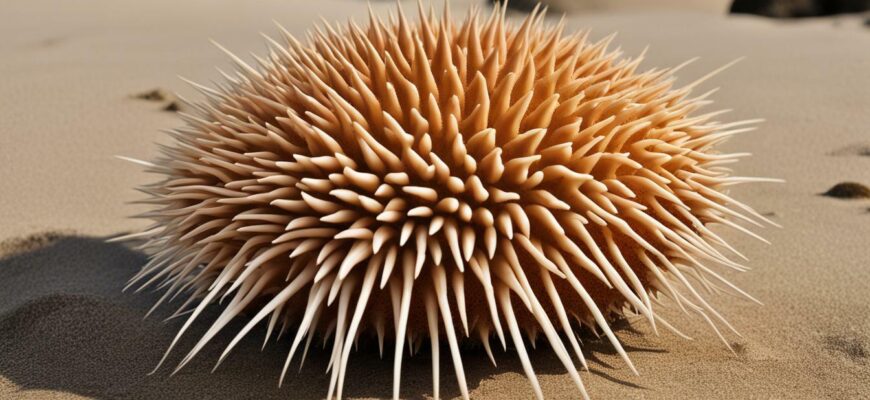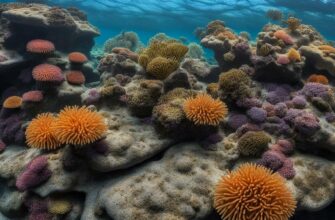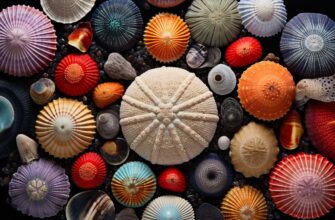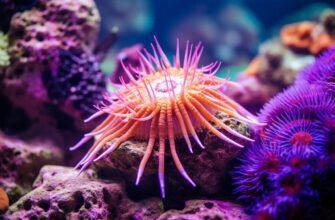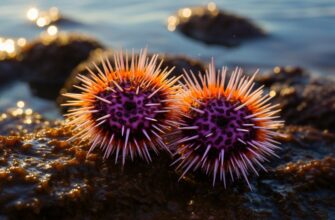Sea urchins are intriguing creatures that inhabit many marine environments around the world. Whether you encounter them while snorkeling, swimming or simply walking on the beach, it is important to know the potential dangers associated with these spiny marine creatures.
So, can sea urchins kill you? While sea urchin stings are unlikely to be fatal, they can still pose a serious health risk. The venomous spines found on sea urchin shells can cause excruciating pain, swelling, and infections. In some cases, they can even lead to limb amputation or permanent disability.
It’s important to take necessary precautions and be aware of the risks associated with sea urchin encounters. In this article, we will explore different types of sea urchins, their venomous spines, and the potential dangers they pose. We will also provide guidance on how to treat sea urchin stings and injuries and how to prevent any future encounters.
- Key Takeaways:
- Understanding Sea Urchin Stings and Injuries
- Types of Poisonous Sea Urchins and Their Effects
- Preventing Sea Urchin Attacks and Ensuring Safety
- Managing Sea Urchin Encounters
- Conclusion
- Stay Safe
- Managing Sea Urchin Encounters
- FAQ
- Q: Can sea urchins be deadly?
- Q: What are the dangers associated with sea urchins?
- Q: How do sea urchin stings and injuries occur?
- Q: What are the health risks of sea urchin encounters?
- Q: How should sea urchin stings be treated?
- Q: Are all sea urchins poisonous?
- Q: How can sea urchin attacks be prevented?
- Q: What should I do if I encounter a sea urchin?
Key Takeaways:
- Sea urchins can pose a serious health risk due to their venomous spines.
- Although unlikely to be fatal, sea urchin stings can cause excruciating pain, swelling, and infection.
- In this article, we will explore sea urchin stings and injuries, and provide practical tips on how to prevent and manage any potential hazards.
Understanding Sea Urchin Stings and Injuries
Sea urchins have a unique defense mechanism that involves venomous spines located on their body surface. These spines are used to protect the sea urchin from predators and can be a danger to humans who come in contact with them. Sea urchin stings and injuries can result in a range of health risks, including infections, allergic reactions, and toxicity.
Sea urchin venom contains various toxins, such as histamine and serotonin, which can produce a range of symptoms, such as swelling, pain, and nausea. The severity of the symptoms may depend on the size and type of the sea urchin. For example, the crown-of-thorns sea urchin, a poisonous species found in the Pacific and Indian Oceans, can cause severe pain and skin irritation.
If you encounter a sea urchin, it is crucial to know how to treat a sea urchin sting properly. The first step is to remove any spines that may be embedded in the skin. Use tweezers or the edge of a plastic card to pull the spines out gently. Be careful not to break off the spines and leave them in the skin, as they may cause further irritation or infection.
| Type of Sea Urchin | Effect on Humans |
|---|---|
| Diadema | Mild injury and pain |
| Crown-of-thorns | Severe pain and skin irritation; possible neurological symptoms |
| Fire | Severe pain, swelling, and redness |
After removing the spines, clean the affected area with antiseptic soap and warm water. Apply an ice pack or a cold, wet cloth to the area to reduce swelling and pain. If necessary, take over-the-counter pain medication, such as ibuprofen or acetaminophen, to alleviate any discomfort. Seek medical attention if the sting causes severe pain, difficulty breathing, or any other serious symptoms.
Sea urchin injuries can be prevented by wearing protective footwear, such as thick-soled water shoes or boots, when walking on the beach or in the water. Avoid touching or handling sea urchins, especially in areas where they are known to be present. If you must handle a sea urchin, use gloves or a barrier, such as a plastic bag, to protect your skin.
Types of Poisonous Sea Urchins and Their Effects
While not all sea urchins are poisonous, some species have venomous spines that can cause serious harm to humans. It is important to know how to recognize these types of sea urchins and understand the potential effects of their venom.
| Species | Location | Effects |
|---|---|---|
| Diadema antillarum | Tropical Atlantic and Caribbean regions | Severe pain, swelling, and possible paralysis |
| Hybrid centrechinus | New Zealand | Severe pain, breathing difficulties, and possible death |
| Asthenosoma varium | Indo-Pacific regions | Severe pain and swelling, potential shock or organ damage |
If you are stung by a poisonous sea urchin, it is important to seek medical attention immediately. The venom can cause serious health complications, and prompt treatment can help minimize the risk of long-term damage.
When in doubt, it is best to err on the side of caution and avoid touching any sea urchins you come across. Even non-poisonous species can cause painful injuries if their spines break off in your skin.
Preventing Sea Urchin Attacks and Ensuring Safety
While sea urchins may not be lethal, their stings can be extremely painful and lead to serious health issues. It’s important to take necessary precautions to avoid encounters and minimize the risks associated with these marine creatures. Here are some tips on how to prevent sea urchin attacks and ensure safety:
- Wear protective footwear: When walking or swimming in areas known for sea urchin presence, it’s recommended to wear sturdy shoes or sandals that cover your feet.
- Be cautious in rocky areas: Sea urchins tend to hide in crevices and rocky areas, so be careful when walking or swimming in such habitats.
- Use a stick: If you’re walking in shallow water, use a stick to probe the ground ahead of you to detect any sea urchins.
- Stay alert: Keep an eye out for any sea urchins in the water or on the shore, and don’t touch or step on them.
By following these simple safety measures, you can greatly minimize the risks of sea urchin injuries and stings.
Note: In case of a sea urchin encounter, it’s essential to follow proper treatment to avoid any complications. Refer to the “Managing Sea Urchin Encounters” section for step-by-step instructions on how to remove sea urchin spines and clean the affected area.
Managing Sea Urchin Encounters
If you find yourself with a sea urchin injury, it is important to act quickly to minimize complications and ensure proper healing. Here are the steps to take:
- Remove the spines: If the spines are still present in the affected area, gently remove them with tweezers or the edge of a credit card. Be careful not to break the spines, as this can make them harder to remove and increase the risk of infection.
- Clean the wound: Once the spines have been removed, wash the affected area with soap and water to reduce the chance of infection. You can also use a solution of vinegar and water to help neutralize any remaining venom.
- Apply first aid: If the wound is bleeding, apply pressure with a clean cloth until it stops. You can also apply a bandage or sterile gauze to help keep the area clean while it heals.
- Seek medical attention: If the injury is severe or shows signs of infection, seek medical attention immediately. Symptoms of infection include redness, swelling, warmth, and pus.
Remember, prevention is key when it comes to avoiding sea urchin injuries. Wear protective footwear when entering the water, and be cautious in areas where sea urchins are known to reside. By taking these precautions and knowing how to manage sea urchin encounters, you can safely enjoy all that the ocean has to offer.
Conclusion
In conclusion, sea urchins can be a potential danger for individuals enjoying marine environments. While sea urchin stings and injuries may not always be deadly, they can cause significant pain and discomfort, and lead to serious health complications if not treated properly.
Stay Safe
It is essential to take necessary precautions while enjoying the sea, such as wearing protective footwear and being cautious in specific habitats known for sea urchin presence. Additionally, it is crucial to be aware of the different types of poisonous sea urchins that exist and the specific effects their venom can have on humans.
Managing Sea Urchin Encounters
In case of a sea urchin encounter, it’s essential to follow proper steps to manage injuries or stings. This includes removing sea urchin spines, cleaning the affected area, and seeking appropriate medical attention if necessary.
By understanding the dangers associated with sea urchins and taking necessary precautions, individuals can continue to enjoy marine environments safely and minimize the potential risks.
FAQ
Q: Can sea urchins be deadly?
A: While sea urchins can cause injuries and stings, they are not typically deadly. However, complications can arise if proper medical treatment is not sought in a timely manner.
Q: What are the dangers associated with sea urchins?
A: The main dangers of sea urchins are their stings and injuries. Their venomous spines can cause pain, swelling, and potential infections. In some cases, allergic reactions or complications may occur.
Q: How do sea urchin stings and injuries occur?
A: Sea urchin stings and injuries usually occur when a person accidentally steps on a sea urchin or brushes against their spines. The spines can penetrate the skin, causing pain and potential venom injection.
Q: What are the health risks of sea urchin encounters?
A: The health risks of sea urchin encounters include localized pain, swelling, redness, and potential infections. In rare cases, allergic reactions or systemic complications can occur.
Q: How should sea urchin stings be treated?
A: To treat sea urchin stings, it is important to remove any spines that may still be embedded in the skin. The affected area should be cleaned thoroughly and an antiseptic applied. Medical attention should be sought if needed.
Q: Are all sea urchins poisonous?
A: Not all sea urchins are poisonous, but some species possess venomous spines. It is important to be aware of the different types of poisonous sea urchins and their specific effects on humans.
Q: How can sea urchin attacks be prevented?
A: Sea urchin attacks can be prevented by taking precautions such as wearing protective footwear when walking in rocky areas and being cautious in habitats known to have sea urchin presence. Avoiding direct contact with sea urchins is key.
Q: What should I do if I encounter a sea urchin?
A: If you encounter a sea urchin, it is advisable to avoid touching it. In case of an accidental sting or injury, carefully remove any spines, clean the affected area, and seek medical attention if necessary.

